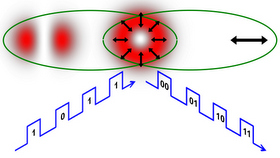A team of physicists from The City College of New York, along with Herriot-Watt University and Corning Incorporated, have demonstrated that the laser beams from ordinary laser pointers can mimic quantum entanglement.
What’s more, they suggest that the behavior of the entanglement itself could lead to a doubling of data speeds when it comes to laser communication.
For those unfamiliar, the layman’s description of quantum entanglement is that when two quantum things are entangled, if one of them is “touched”, the other “feels” it, even if the two things are separated by a distance.
Albert Einstein described it as being a “spooky action at a distance.”
“At the heart of quantum entanglement is ‘nonseparability’ – two entangled things are described by an unfactorizable equation,” explains City College PhD student Giovanni Milione. “Interestingly, a conventional laser beam (a laser pointer)’s shape and polarization can also be nonseparable.”
In order to make the laser beam’s shape and polarization nonseparable, the team converted it into a vector beam; that is, a beam which has a polarization dependent shape. After that was achieved, they used off-the-shelf components to “touch” only its polarization. When they did this, it showed the beam could be encoded as two bits of information; surprising because that’s twice as much information that could be encoded as when the laser beam was separable.

“In principal, this could be used to double the data speed of laser communication,” said CCNY Distinguished Professor of Physics Robert Alfano. “While there’s no 'spooky action at a distance,' it's amazing that quantum entanglement aspects can be mimicked by something that simple.”
Full details of the project, which was supported partly by the Army Research Officer, was published in Optic Letters under the title “Using the nonseparability of vector beams to encode information for optical communication”.
https://www.osapublishing.org/ol/abstract.cfm?uri=ol-40-21-4887
Advertisement
Learn more about Electronic Products Magazine





